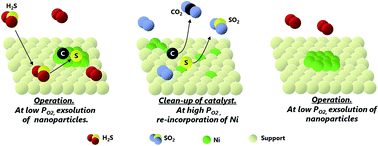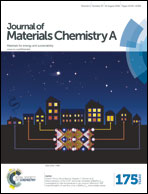Smart material concept: reversible microstructural self-regeneration for catalytic applications†
Abstract
This paper presents a proof-of-concept study and demonstrates the next generation of a “smart” catalyst material, applicable to high temperature catalysis and electro-catalysis such as gas processing and as a catalyst for solid oxide cells. A modified citrate-gel technique was developed for the synthesis of LaxSr1−1.5xTi1−yNiyO3−δ. This method allowed the synthesis of single phase materials with a high specific surface area, after the first calcination step at temperatures as low as 650 °C. Up to 5 at% of nickel could be incorporated into the perovskite structure at this low calcination temperature. X-ray powder diffraction and microscopy techniques have proven the exsolution of nickel nanoclusters under low oxygen partial pressure. The amount of exsoluted nickel nanoparticles was sensitive to surface finishing, whereby much more exsoluted nanoparticles were observed on pre-treated and polished surfaces as compared to original ones. Increasing A-site deficiency leads to a larger number of nickel particles on the surface, indicating a destabilizing influence of the A-site vacancies on the B-site metal cations. Repetitive redox cycles prove that the nickel exsolution and re-integration is a fully reversible process. These materials working in a cyclic and repetitive way may overcome the drawbacks of currently used conventional catalysts used for high temperature systems and overcome major degradation issues related to catalyst poisoning and coarsening-induced aging.


 Please wait while we load your content...
Please wait while we load your content...